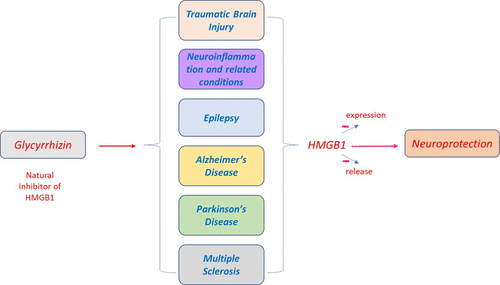当前位置:
X-MOL 学术
›
ACS Chem. Neurosci.
›
论文详情
Our official English website, www.x-mol.net, welcomes your
feedback! (Note: you will need to create a separate account there.)
Potential Neuroprotective Effect of the HMGB1 Inhibitor Glycyrrhizin in Neurological Disorders.
ACS Chemical Neuroscience ( IF 4.1 ) Pub Date : 2020-02-04 , DOI: 10.1021/acschemneuro.9b00640 Yam Nath Paudel 1 , Efthalia Angelopoulou 2 , Bridgette Semple 3, 4 , Christina Piperi 2 , Iekhsan Othman 1 , Mohd Farooq Shaikh 1
ACS Chemical Neuroscience ( IF 4.1 ) Pub Date : 2020-02-04 , DOI: 10.1021/acschemneuro.9b00640 Yam Nath Paudel 1 , Efthalia Angelopoulou 2 , Bridgette Semple 3, 4 , Christina Piperi 2 , Iekhsan Othman 1 , Mohd Farooq Shaikh 1
Affiliation

|
Glycyrrhizin (glycyrrhizic acid), a bioactive triterpenoid saponin constituent of Glycyrrhiza glabra, is a traditional medicine possessing a plethora of pharmacological anti-inflammatory, antioxidant, antimicrobial, and antiaging properties. It is a known pharmacological inhibitor of high mobility group box 1 (HMGB1), a ubiquitous protein with proinflammatory cytokine-like activity. HMGB1 has been implicated in an array of inflammatory diseases when released extracellularly, mainly by activating intracellular signaling upon binding to the receptor for advanced glycation end products (RAGE) and toll-like receptor 4 (TLR4). HMGB1 neutralization strategies have demonstrated disease-modifying outcomes in several preclinical models of neurological disorders. Herein, we reveal the potential neuroprotective effects of glycyrrhizin against several neurological disorders. Emerging findings demonstrate the therapeutic potential of glycyrrhizin against several HMGB1-mediated pathological conditions including traumatic brain injury, neuroinflammation and associated conditions, epileptic seizures, Alzheimer's disease, Parkinson's disease, and multiple sclerosis. Glycyrrhizin's effects in neurological disorders are mainly attributed to the attenuation of neuronal damage by inhibiting HMGB1 expression and translocation as well as by downregulating the expression of inflammatory cytokines. A large number of preclinical findings supports the notion that glycyrrhizin might be a promising therapeutic alternative to overcome the shortcomings of the mainstream therapeutic strategies against neurological disorders, mainly by halting disease progression. However, future research is warranted for a deeper exploration of the precise underlying molecular mechanism as well as for clinical translation.
中文翻译:

HMGB1抑制剂甘草甜素在神经系统疾病中的潜在神经保护作用。
甘草酸(甘草酸)是甘草的一种生物活性三萜皂苷成分,是一种具有多种药理抗炎,抗氧化,抗微生物和抗衰老特性的传统药物。它是已知的高迁移率族盒1(HMGB1)的药理抑制剂,HMGB1是一种具有促炎细胞因子样活性的普遍存在的蛋白质。HMGB1在细胞外释放时与一系列炎症性疾病有关,主要是通过与晚期糖基化终产物(RAGE)和toll样受体4(TLR4)受体结合后激活细胞内信号传导。HMGB1中和策略已在多种神经系统疾病的临床前模型中证明了改善疾病的结果。在这里 我们揭示了甘草甜素对几种神经系统疾病的潜在神经保护作用。新兴发现表明甘草甜素对几种HMGB1介导的病理性疾病具有治疗潜力,这些疾病包括脑外伤,神经炎症和相关疾病,癫痫发作,阿尔茨海默氏病,帕金森氏病和多发性硬化症。甘草甜素在神经系统疾病中的作用主要归因于通过抑制HMGB1的表达和易位以及下调炎性细胞因子的表达来减轻神经元损伤。大量的临床前发现支持以下观点:甘草甜素可能是克服主要针对神经疾病的主要治疗策略的缺点的有希望的治疗选择,主要是通过阻止疾病进展。但是,有必要进行进一步的研究以更深入地探索确切的潜在分子机制以及进行临床翻译。
更新日期:2020-02-04
中文翻译:

HMGB1抑制剂甘草甜素在神经系统疾病中的潜在神经保护作用。
甘草酸(甘草酸)是甘草的一种生物活性三萜皂苷成分,是一种具有多种药理抗炎,抗氧化,抗微生物和抗衰老特性的传统药物。它是已知的高迁移率族盒1(HMGB1)的药理抑制剂,HMGB1是一种具有促炎细胞因子样活性的普遍存在的蛋白质。HMGB1在细胞外释放时与一系列炎症性疾病有关,主要是通过与晚期糖基化终产物(RAGE)和toll样受体4(TLR4)受体结合后激活细胞内信号传导。HMGB1中和策略已在多种神经系统疾病的临床前模型中证明了改善疾病的结果。在这里 我们揭示了甘草甜素对几种神经系统疾病的潜在神经保护作用。新兴发现表明甘草甜素对几种HMGB1介导的病理性疾病具有治疗潜力,这些疾病包括脑外伤,神经炎症和相关疾病,癫痫发作,阿尔茨海默氏病,帕金森氏病和多发性硬化症。甘草甜素在神经系统疾病中的作用主要归因于通过抑制HMGB1的表达和易位以及下调炎性细胞因子的表达来减轻神经元损伤。大量的临床前发现支持以下观点:甘草甜素可能是克服主要针对神经疾病的主要治疗策略的缺点的有希望的治疗选择,主要是通过阻止疾病进展。但是,有必要进行进一步的研究以更深入地探索确切的潜在分子机制以及进行临床翻译。











































 京公网安备 11010802027423号
京公网安备 11010802027423号